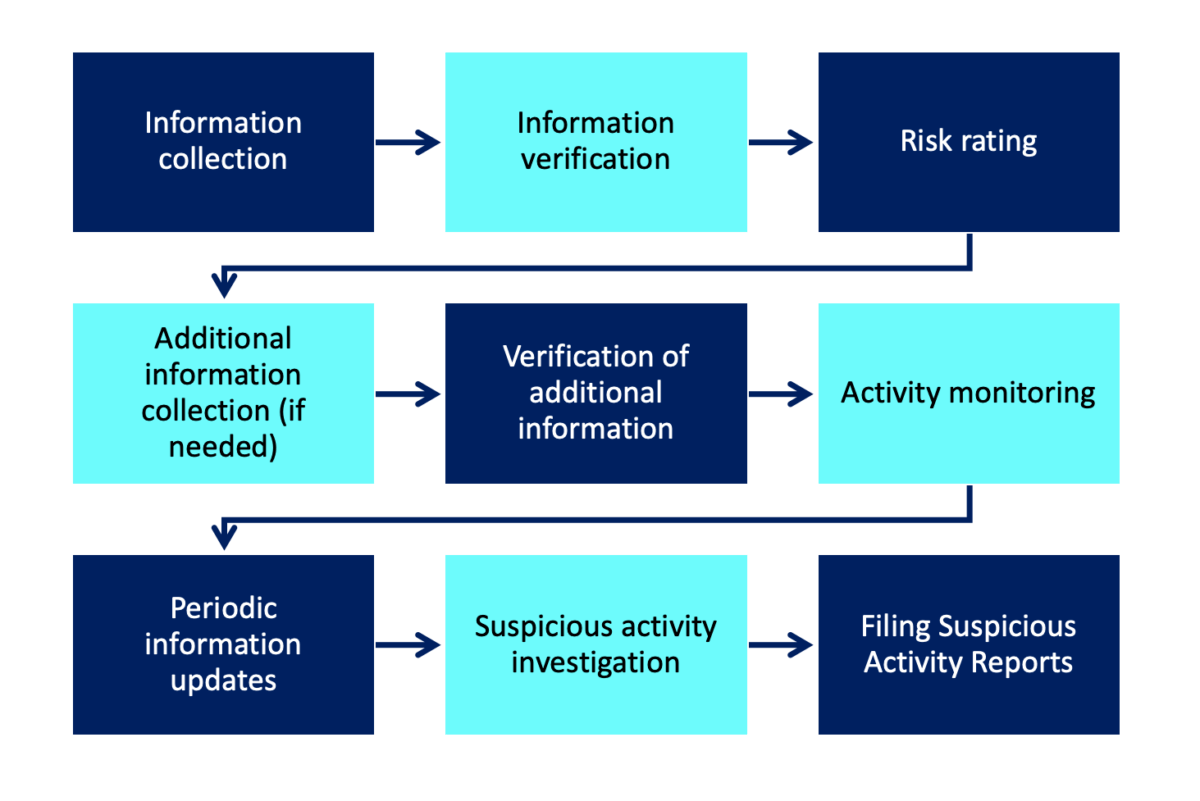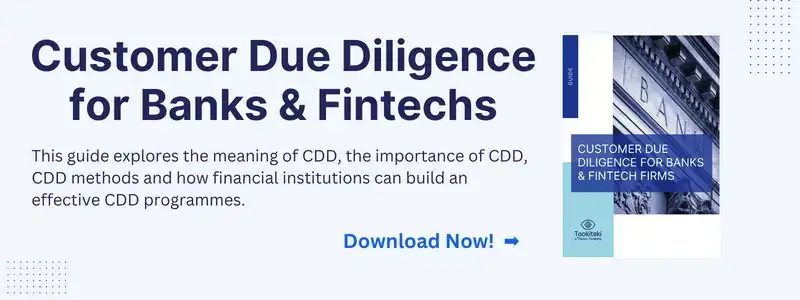Difference Between CDD and KYC: Unraveling Financial Security Measures
The financial landscape is undergoing a radical transformation. With this shift, comes the challenge of ensuring the integrity of financial transactions and maintaining the trust of customers. In this context, two vital processes have emerged as the bedrock of secure business operations: KYC (Know Your Customer) and CDD (Customer Due Diligence).
Let us delve into more detail and understand KYC and CDD along with the relationship and difference between CDD and KYC.
KYC and CDD - Understanding the Pillars of Financial Integrity
KYC is the initial step, where businesses verify the identity of their customers. CDD, on the other hand, is an ongoing process that involves continuously monitoring customer behavior and assessing risks associated with it. Both are pivotal in preventing financial crimes. Let us discuss these in more detail.
1. KYC
During KYC, businesses gather a comprehensive set of information about their customers, ranging from personal details to financial histories. This careful gathering of customer information ensures that businesses know their customers truly, preventing identity theft and fraud right from the beginning. KYC acts like a safety net, giving businesses the confidence to interact with people and organizations. This initial step not only fulfills regulatory requirements but also establishes trust and credibility, forming the foundation upon which further interactions are built.
2. CDD
While KYC sets the stage, CDD steps into the ongoing narrative of the customer-business relationship. CDD operates on multiple levels, adapting its scrutiny based on the perceived risk associated with the customer. For low-risk customers, CDD involves periodic reviews to ensure that their profiles remain accurate. Medium and high-risk customers undergo enhanced CDD, a process that involves a deeper analysis of transactions, relationships, and potential red flags.
CDD's significance lies in its ability to identify unusual or suspicious activities. By continuously monitoring customer transactions and behavior, CDD can swiftly detect anomalies that might indicate terrorist financing, money laundering, or other illicit activities. This continuous scrutiny ensures that businesses stay one step ahead of criminals, mitigating risks effectively and upholding the integrity of their operations.
CDD Process

Relationship Between KYC and CDD
KYC and CDD are not isolated processes; they are interlinked threads in the fabric of financial security. KYC provides the initial identity verification, creating the customer's profile. CDD then takes this profile and subjects it to constant evaluation, ensuring that it remains accurate and reliable. The symbiotic relationship between KYC and CDD is what makes them formidable. Together, they create a seamless continuum of security, enabling businesses to not only comply with regulatory standards but also protect their assets and reputation.
In today's digital age, where financial transactions occur at the speed of light and borders are no barriers, the collaborative efforts of KYC and CDD are indispensable. By understanding the nuances of KYC and CDD, businesses can not only navigate the complex landscape of financial regulations but also forge enduring relationships with their customers, built on a foundation of integrity and transparency.
Key Steps in the KYC Process
1. Customer Identification
Businesses collect comprehensive information about their customers, ensuring accuracy and completeness. This step is pivotal in creating a unique customer profile within the organization's database.
2. Document Verification
Customers are required to submit official documents supporting the provided information. This might involve documents like passports, driver's licenses, or utility bills, essentially official papers issued by the government. Businesses often use advanced verification tools to confirm their authenticity.
3. Risk Assessment
KYC also involves assessing the risk level associated with a customer. High-risk customers, such as politically exposed persons (PEPs) or individuals from countries with a high incidence of financial crimes, undergo enhanced due diligence, involving more rigorous scrutiny.
4. Regulatory Compliance
KYC processes are designed to comply with various national and global regulations. Adherence to these regulations ensures that businesses are operating within legal boundaries and helps in preventing money laundering and terrorist financing.
Learn More: Understanding the Meaning of KYC and its Difference with AML
Different CDD Levels
By employing different levels of CDD, businesses can effectively manage risks and maintain the integrity of their operations. Let's explore the various CDD levels in detail, understanding how they contribute to a secure financial environment.
1. Basic CDD
Basic CDD is applied to customers categorized as low-risk. These are typically individuals or entities with straightforward financial activities and backgrounds. Basic CDD involves essential identity verification, such as confirming the customer's name, address, and other pertinent details. While the scrutiny is less intensive compared to higher levels of CDD, it still plays a critical role in ensuring the accuracy of customer information.
2. Enhanced CDD
Enhanced CDD comes into play when dealing with customers of moderate risk. This could include individuals with complex financial transactions, high net worth, or those from countries with a high incidence of financial crimes. Enhanced CDD involves a more comprehensive analysis, delving deeper into the customer's background, transaction patterns, and potential red flags. This level of scrutiny helps businesses identify and assess any unusual activities, ensuring that they are promptly investigated.
3. Periodic CDD
Even after the initial KYC process, customer profiles can change over time. Periodic CDD is crucial for maintaining the accuracy of customer information in the long term. Businesses conduct regular reviews of customer profiles, ensuring that they remain up-to-date and reflective of any changes in financial behavior or risk factors. By periodically revisiting customer profiles, businesses can adapt to evolving risks and promptly address any discrepancies.
Also Read: Customer Due Diligence (CDD): Strengthening Trust and Security
Difference Between CDD and KYC
The terms CDD and KYC are often used interchangeably, but they are distinct processes, each with a specific role in safeguarding businesses against financial crimes. Let us understand the difference between CDD and KYC in simple terms.
KYC, often considered the first line of defense, focuses on the initial verification of a customer's identity. CDD, on the other hand, operates on a different level. It involves continuous monitoring and assessment of customer activities. While KYC is the opening chapter, CDD is the ongoing narrative, ensuring that the story remains consistent and trustworthy.
It's crucial to emphasize that CDD holds a pivotal role within the Anti-Money Laundering (AML) program. Regular assessments, including evaluations of transaction volume, monetary sums involved, and geographical spread, are conducted to ensure compliance and effectiveness. Understanding this difference between CDD and KYC empowers businesses to fortify their operations and uphold the highest standards of financial security and compliance.
KYC and CDD Regulations Across Different Countries
The specific regulations and practices surrounding KYC and CDD can vary significantly from one country to another due to different legal frameworks.. Here’s an overview of how KYC and CDD regulations operate in different countries:
1. United States
In the U.S., financial institutions are bound by the Bank Secrecy Act (BSA) which mandates strict KYC and CDD practices. Additionally, the USA PATRIOT Act requires institutions to establish Customer Identification Programs (CIPs) and conduct enhanced due diligence for high-risk customers, including monitoring transactions and reporting suspicious activities to the Financial Crimes Enforcement Network (FinCEN).
2. European Union
In the EU, the Fourth Anti-Money Laundering Directive (AMLD4) lays out KYC and CDD obligations for member states. The EU's Fifth Anti-Money Laundering Directive (AMLD5) introduced additional measures, including stricter rules for enhanced due diligence on politically exposed persons (PEPs) and beneficial owners. The EU countries often collaborate closely to ensure consistency in their approach to combating financial crimes.
3. United Kingdom
The UK’s KYC and CDD regulations align with EU directives, but post-Brexit, it has the flexibility to develop its own approach. The UK’s Financial Conduct Authority (FCA) sets out guidelines for financial institutions, ensuring they adhere to robust KYC and CDD practices. The focus is on risk-based assessments and customer verification.
4. India
In India, KYC regulations are overseen by the Reserve Bank of India (RBI) and the Securities and Exchange Board of India (SEBI). The KYC process includes verification of identity, address, and financial documents. Aadhaar, a biometric identification system, is widely used for KYC purposes, making the process efficient and secure.
5. China
China's KYC regulations are governed by the People's Bank of China and the China Banking and Insurance Regulatory Commission. Financial institutions must conduct due diligence on their customers, and the government strictly monitors large transactions and suspicious activities. Mobile payments and digital identity verification have become integral parts of KYC practices in the country.
Technology Advancements in KYC and CDD Processes
Artificial Intelligence (AI), machine learning algorithms, and sophisticated data analytics have become integral tools, significantly enhancing the efficiency and accuracy of these processes. One of the notable advancements lies in automated document verification systems. AI-powered solutions can swiftly and accurately verify identity documents, ensuring that the information provided by customers is legitimate. These systems not only reduce manual errors but also expedite the KYC process, enabling businesses to onboard customers faster while maintaining high levels of accuracy.
Moreover, machine learning algorithms have enabled intelligent risk assessment in CDD. By analyzing vast datasets and detecting patterns, these algorithms can identify suspicious transactions and behaviors in real time. This proactive approach allows businesses to stay ahead of financial criminals, promptly flagging potential risks and ensuring timely intervention.
Final Thoughts
Understanding the nuances and differences between CDD and KYC is not just a matter of regulatory compliance; it's a testament to a business's commitment to trust and transparency. By adopting robust KYC protocols, businesses establish a firm foundation of authenticity, ensuring that every transaction begins with confidence. The ongoing vigilance provided by CDD then perpetuates this trust, assuring that the customer-business relationship remains secure and free from illicit activities.
Anti-Financial Crime Compliance with Tookitaki?




